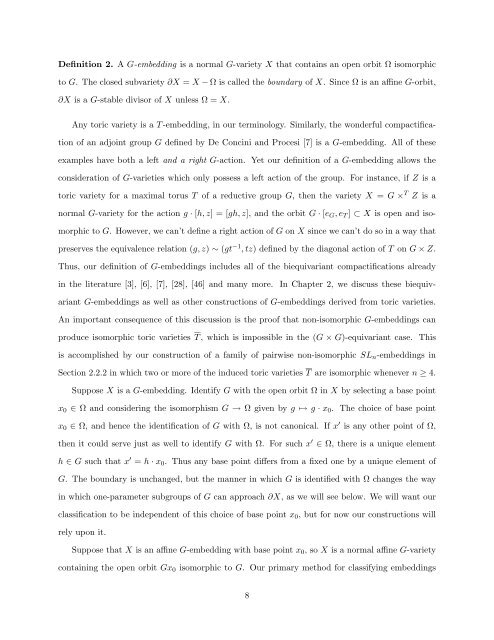Equivariant Embeddings of Algebraic Groups
Equivariant Embeddings of Algebraic Groups
Equivariant Embeddings of Algebraic Groups
Create successful ePaper yourself
Turn your PDF publications into a flip-book with our unique Google optimized e-Paper software.
Definition 2. A G-embedding is a normal G-variety X that contains an open orbit Ω isomorphic<br />
to G. The closed subvariety ∂X = X − Ω is called the boundary <strong>of</strong> X. Since Ω is an affine G-orbit,<br />
∂X is a G-stable divisor <strong>of</strong> X unless Ω = X.<br />
Any toric variety is a T -embedding, in our terminology. Similarly, the wonderful compactification<br />
<strong>of</strong> an adjoint group G defined by De Concini and Procesi [7] is a G-embedding. All <strong>of</strong> these<br />
examples have both a left and a right G-action. Yet our definition <strong>of</strong> a G-embedding allows the<br />
consideration <strong>of</strong> G-varieties which only possess a left action <strong>of</strong> the group. For instance, if Z is a<br />
toric variety for a maximal torus T <strong>of</strong> a reductive group G, then the variety X = G × T Z is a<br />
normal G-variety for the action g · [h, z] = [gh, z], and the orbit G · [e G , e T ] ⊂ X is open and isomorphic<br />
to G. However, we can’t define a right action <strong>of</strong> G on X since we can’t do so in a way that<br />
preserves the equivalence relation (g, z) ∼ (gt −1 , tz) defined by the diagonal action <strong>of</strong> T on G × Z.<br />
Thus, our definition <strong>of</strong> G-embeddings includes all <strong>of</strong> the biequivariant compactifications already<br />
in the literature [3], [6], [7], [28], [46] and many more. In Chapter 2, we discuss these biequivariant<br />
G-embeddings as well as other constructions <strong>of</strong> G-embeddings derived from toric varieties.<br />
An important consequence <strong>of</strong> this discussion is the pro<strong>of</strong> that non-isomorphic G-embeddings can<br />
produce isomorphic toric varieties T , which is impossible in the (G × G)-equivariant case. This<br />
is accomplished by our construction <strong>of</strong> a family <strong>of</strong> pairwise non-isomorphic SL n -embeddings in<br />
Section 2.2.2 in which two or more <strong>of</strong> the induced toric varieties T are isomorphic whenever n ≥ 4.<br />
Suppose X is a G-embedding. Identify G with the open orbit Ω in X by selecting a base point<br />
x 0 ∈ Ω and considering the isomorphism G → Ω given by g ↦→ g · x 0 . The choice <strong>of</strong> base point<br />
x 0 ∈ Ω, and hence the identification <strong>of</strong> G with Ω, is not canonical. If x ′ is any other point <strong>of</strong> Ω,<br />
then it could serve just as well to identify G with Ω. For such x ′ ∈ Ω, there is a unique element<br />
h ∈ G such that x ′ = h · x 0 . Thus any base point differs from a fixed one by a unique element <strong>of</strong><br />
G. The boundary is unchanged, but the manner in which G is identified with Ω changes the way<br />
in which one-parameter subgroups <strong>of</strong> G can approach ∂X, as we will see below. We will want our<br />
classification to be independent <strong>of</strong> this choice <strong>of</strong> base point x 0 , but for now our constructions will<br />
rely upon it.<br />
Suppose that X is an affine G-embedding with base point x 0 , so X is a normal affine G-variety<br />
containing the open orbit Gx 0 isomorphic to G. Our primary method for classifying embeddings<br />
8
















